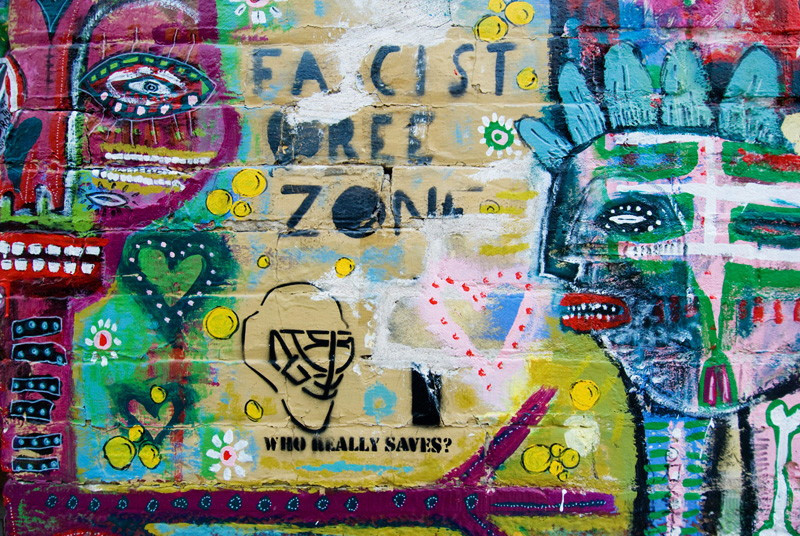Painting the city
Artists are fighting for legalized graffiti walls, but will the city listen?
It’s not easy being Jett Hansell these days. The 20-year-old is currently facing 75 charges of mischief under $5,000 for her role in a rash of graffiti incidents in Osborne Village last year and has a nightly curfew of 10 p.m.
“At first I was depressed and angry at people and I wanted to express it,” she said of getting into graffiti three years ago. “Then it turned into something else. It became a message and a statement that there will always be abstract things in life and you can’t always stop it.”
Hansell was charged in December 2008 along with five other people for 346 counts of mischief under $5,000 for tagging up Osborne Village – the total damage estimated at $70,000.
Police spokesman Constable Jason Michalyshen said it was the most significant graffiti bust he’s seen.
“It paints a bit of a picture of the damage that just six people can have to the community,” he said.
Hansell said she now understands the magnitude of her actions and is trying to fix them. She is currently fighting for legal graffiti walls in the city, where artists are free to paint any time. A petition is circulating the city and she currently has over 1,000 members on her Facebook group.
“ It’s almost as if this young generation is saying ‘Screw you guys. If you’re not going to listen to me when I write you letters or call you, you’ll pay attention to me when I tag your buildings.’
Steve Wilson, executive director for Graffiti Art Programming Inc.
“The city is always looking at ways at boosting morale with ‘spirited energy’ and all these slogans,” Hansell said. “But smaller details make up the city. Something like this would actually help to give it vibe. Once we start getting more creative in the city, people will open their minds a bit more. It’s a movement.”
Hansell isn’t the only one fighting for legal graffiti walls. Steve Wilson, executive director for Graffiti Art Programming Inc. on Higgins Avenue, has been trying to do it for a decade. However, red tape has held up the process, and Wilson’s pleas have never reached city council.
“The people who have been opposing it for 10 years are in the exact same position, so there hasn’t been any movement in convincing them that we should have legal graffiti walls,” Wilson said. “They’ve been entrenched in their position for years, and until they move on, not much is going to change.”
Although the issue of graffiti walls locally seems to be a non-starter, views towards graffiti are changing.
Wilson said that in the 10 years his gallery has been open, people’s misconceptions of graffiti have been slowly changing, opening the debate as to whether or not graffiti is art or an act of vandalism.
“Many people make the mistake of associating [graffiti] with gang activity,” Wilson explained of graffiti’s nefarious cousin, tagging. “It’s been my experience that the vast majority of people who come to our gallery to see graffiti art on canvas, get a close up look at the color, harmony, and balance, and they see that yes, it is art.”
Hansell agreed.
“Graffiti has its own negativity tagged along with it,” she said. “No one’s going to notice it because they already made an opinion about it. [Legal walls] will be a good gateway to opening more people’s minds.”
Michalyshen, a former Corydon beat officer, admitted that he’s seen beautiful graffiti art in the city and appreciates the talent, but stressed the law.
“As long as it’s done in a lawful way, it can be referred to as art, but in the form of vandalizing property or tagging, it’s not art,” he said. “Those costs come out of business owners’ pockets and negatively affects the community.”
Meanwhile, Wilson sees the existence of graffiti as the clash between two very different generations.
“At this moment in history, we have the old established society butting heads with a younger generation who is looking around them and seeing financial crisis,” he said. “They’re seeing tremendous greed from established adults in the city, looking at those abuses and they’re protesting. They’re voicing their opposition to the way things are being run, and in many cases, they look at politicians as being corrupt and unresponsive to their points of view. It’s almost as if this young generation is saying ‘Screw you guys. If you’re not going to listen to me when I write you letters or call you, you’ll pay attention to me when I tag your buildings.’”
Published in Volume 63, Number 27 of The Uniter (May 20, 2009)







